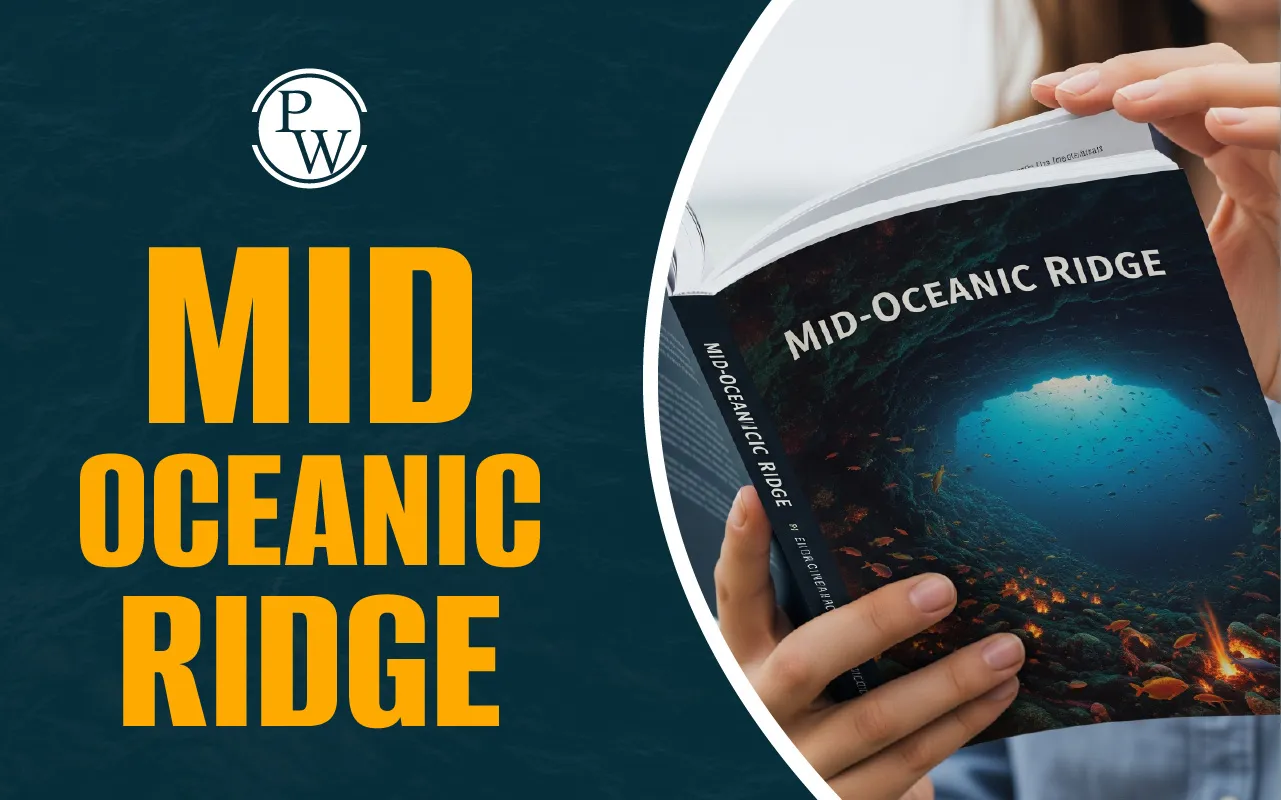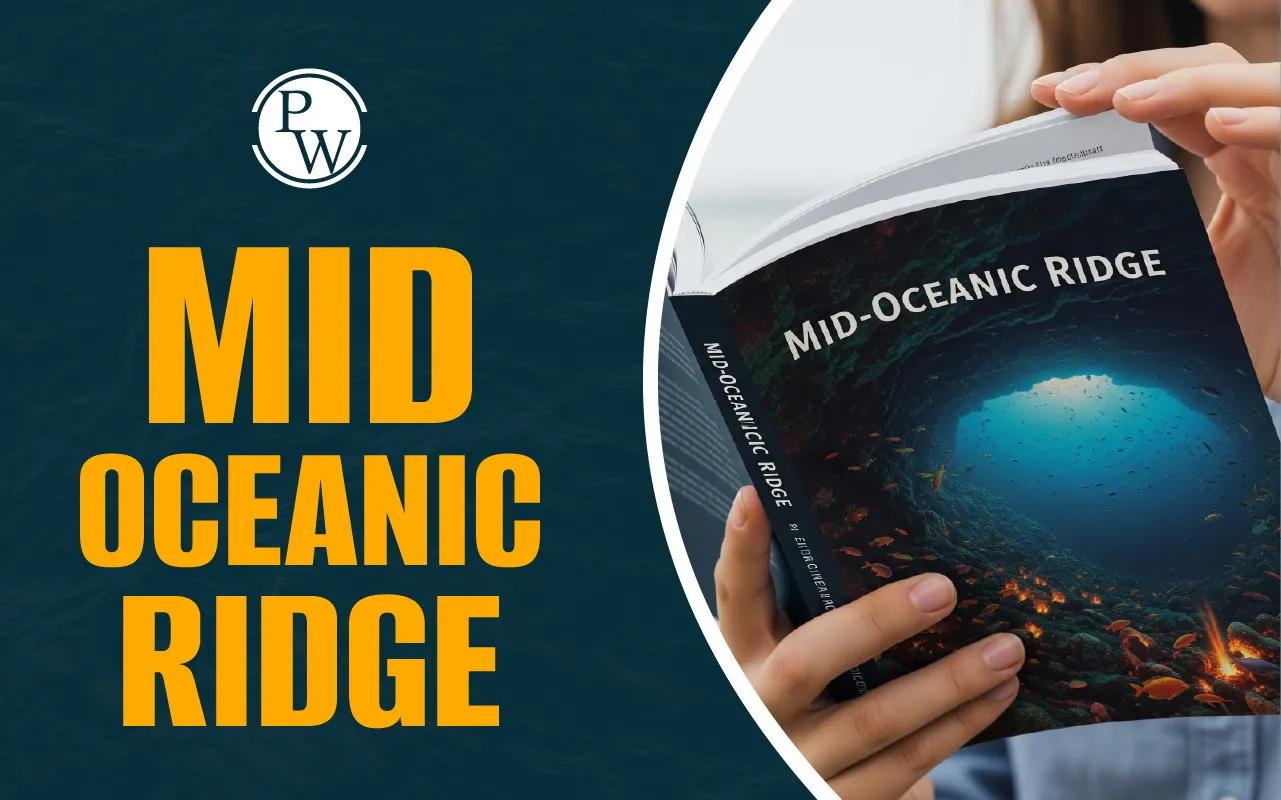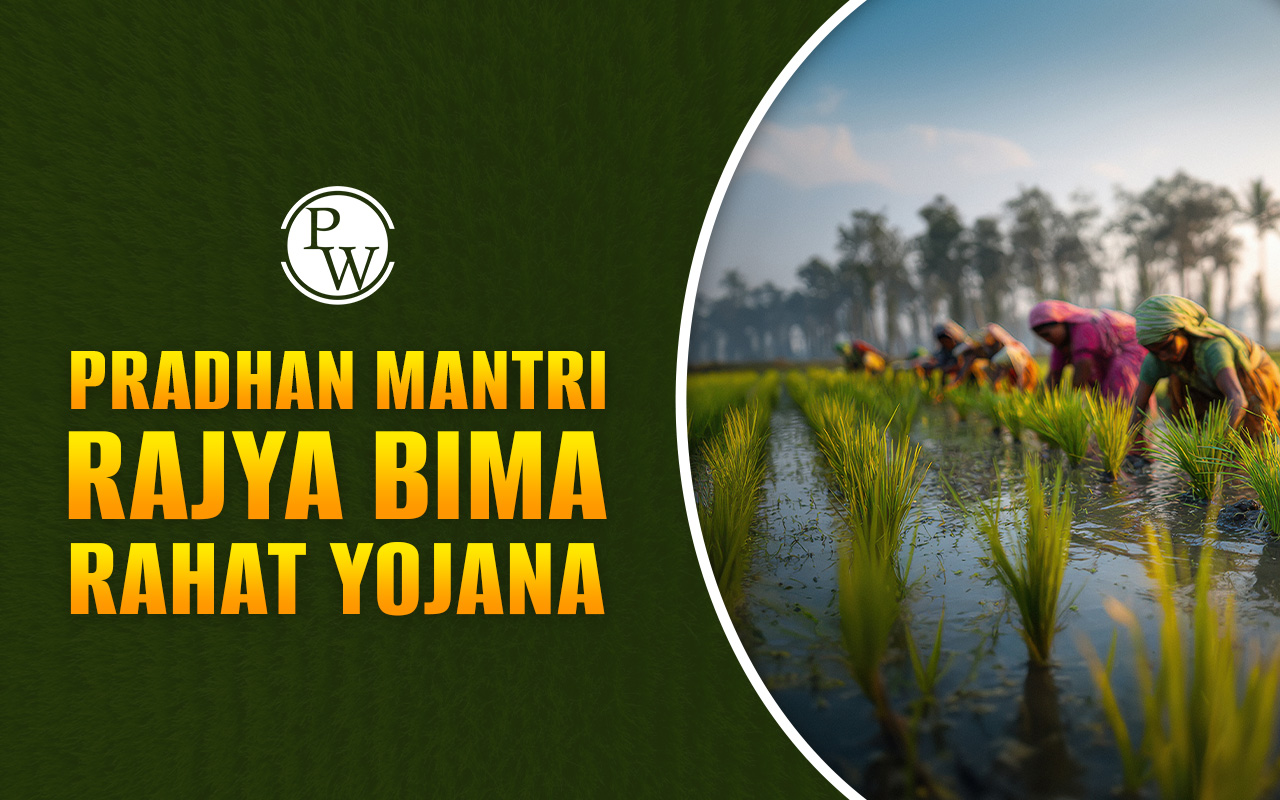

Mid-Oceanic Ridge is a long, continuous chain of underwater mountains found in the middle of the world's oceans. It is formed by the movement of Earth's tectonic plates and shapes the ocean floor, influences plate tectonics, and even impacts ocean life. Understanding Mid-Oceanic Ridges is crucial for UPSC aspirants, especially for Geography and GS Paper 1. Read on to learn about Mid-Oceanic Ridge!
What Is Mid-Oceanic Ridge?
A Mid-Oceanic Ridge is a long chain of underwater mountains formed by tectonic activity. These ridges are found where two tectonic plates are moving away from each other. As the plates separate, molten rock or magma rises from the Earth's mantle. This magma cools and solidifies, forming new oceanic crust. Over time, this continuous process builds a ridge of elevated land on the ocean floor.
The ridge is not a single peak but a wide area of rough terrain with peaks, valleys, and cracks. Some of these ridges even break the surface of the ocean and form islands. A famous example is Iceland, which sits directly on the Mid-Atlantic Ridge. This ridge system is not only the longest mountain chain on Earth, extending over 65,000 km, but also one of the most active geological zones.
Mid-Oceanic Ridge connects continents and shows us how the Earth continues to evolve beneath the oceans.
Mid-Oceanic Ridge Formation
The formation of a Mid-Oceanic Ridge is a result of a process known as seafloor spreading. This occurs at divergent plate boundaries, where two tectonic plates move apart. As the plates separate, the pressure in the Earth's mantle below decreases. This causes hot magma to rise through the gap created by the separating plates. When this magma reaches the ocean floor, it cools quickly and solidifies into new crust.
This process repeats constantly, pushing older crust away from the ridge and forming new crust at the centre. The rate of spreading differs from place to place, ranging from 2 to 10 centimetres per year. Though this may seem slow, over millions of years, it significantly reshapes the ocean floor.
At the centre of many Mid-Oceanic Ridges lies a rift valley, which marks the exact line where the plates are moving apart. This valley is often surrounded by high ridges made from the newly formed crust. The entire structure is a dynamic zone of volcanic activity, minor earthquakes, and continuous creation of new seafloor.
Characteristics of Mid-Oceanic Ridge
Mid-Oceanic Ridges are unique and complex geological features. They are not only vast in size but also highly active and constantly evolving with characteristics like:
-
Continuous Chain: The Mid-Oceanic Ridge system forms the longest chain of mountains in the world.
-
Divergent Boundaries: These ridges mark the boundaries where two tectonic plates move apart.
-
Rift Valleys: A deep central valley is often present along the ridge, where magma emerges.
-
New Crust Formation: New oceanic crust forms as magma rises and cools at the ridge.
-
Volcanic Activity: Many parts of the ridge have active volcanoes under the sea.
-
Hydrothermal Vents: These vents release hot water and minerals, creating unique ecosystems.
-
Earthquake Zones: The movement of plates causes frequent minor earthquakes.
The Mid-Oceanic Ridge is also much cooler near the edges, where the crust is older. The temperature is highest near the ridge centre, where new magma emerges. The age of the oceanic crust increases as you move away from the ridge.
Distribution of Mid-Oceanic Ridge
Mid-Oceanic Ridges are not isolated to one region but are spread across all the world’s oceans. The global ridge system forms a connected network that divides the ocean floor. Major distribution of Mid-Oceanic Ridges includes:
Atlantic Ocean
-
Mid-Atlantic Ridge: A central underwater ridge running north to south through the Atlantic Ocean, from Iceland to the southern hemisphere near 60°S. It's the most studied and prominent mid-ocean ridge.
-
Reykjanes Ridge: A southern extension of the Mid-Atlantic Ridge from Iceland, shaped by volcanic activity due to a mantle hotspot.
Indian Ocean
-
Mid-Indian Ridge: Extends northward from the South Atlantic and splits into two arms—one heading toward the Gulf of Aden, the other toward the southeast Indian Ocean.
-
Carlsberg Ridge: A geologically active section located between the Gulf of Aden and Rodrigues Island.
-
Southwest Indian Ridge: Lies between Africa and Antarctica, linking the Mid-Indian and Southeast Indian ridges.
-
Southeast Indian Ridge: Located between Australia and Antarctica; features moderate rates of seafloor spreading.
-
Additional Features: Includes linear and isolated ridges like the Ninety East, Investigator, Chain, Amirante, Davie, and Murray ridges, each with distinct geological characteristics.
Pacific Ocean
-
East Pacific Rise: Extends from the Gulf of California down the Pacific coast of South America; known for some of the fastest seafloor spreading rates globally.
-
Pacific-Antarctic Ridge: Stretches from a region south of New Zealand toward South America, eventually merging with the East Pacific Rise.
-
Other Active Zones: Includes the Gorda, Juan de Fuca, and Explorer ridges near North America, along with smaller spreading centers in areas like the Fiji Basin, Woodlark Basin, Scotia Sea, and near the Galápagos Islands.
Arctic Ocean
-
Gakkel Ridge: A slow-moving spreading center beneath the Arctic Ocean, marking the northernmost section of the global mid-ocean ridge system.
Importance of Mid-Oceanic Ridge
Mid-Oceanic ridges have great scientific and environmental importance:
-
Plate Tectonics: They help us understand how the Earth's plates move. Seafloor spreading explains the movement of continents and the formation of ocean basins.
-
New Crust Formation: Mid-Oceanic Ridges constantly create new crust. This shows that the Earth is active and evolving.
-
Marine Biodiversity: Hydrothermal vents found near these ridges support rare marine life. These organisms survive in extreme conditions without sunlight.
-
Mineral Resources: These ridges are rich in minerals like copper, zinc, and rare earth metals. In the future, they could become important for deep-sea mining.
-
Climate Regulation: The movement of tectonic plates affects ocean currents. This, in turn, influences global climate patterns.
-
Scientific Research: Ridges offer a natural laboratory to study Earth's interior, ocean life, and extreme environments.
-
Natural Hazards: Understanding ridge activity helps predict undersea earthquakes and tsunamis. This can save lives and improve disaster preparedness.
In summary, Mid-Oceanic Ridges play a key role in shaping our planet. They are places where new crust is made and where continents and oceans slowly shift over millions of years.
Want to master such topics in Geography and GS? Explore PW’s UPSC Courses and take your UPSC prep to the next level today!
Mid-Oceanic Ridge FAQs
What is the Mid-Oceanic Ridge made of?
Which ocean has the longest Mid-Oceanic Ridge?
What is the Mid-Oceanic Ridge in the Atlantic Ocean?
Do earthquakes occur along Mid-Oceanic Ridges?
Are there volcanoes along the Mid-Oceanic Ridge?











